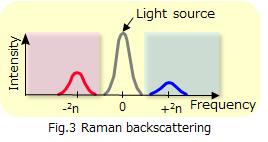"Early detection of failures in refractory materials"
Customer Concerns
Early detection of failures in refractory materials
Temperatures inside a harsh condition reactor such as synthesis gas reactor that produces carbon monoxide can reach as high as 1,600 degrees Celsius, and the outer surface of the reactor vessel can get as hot as 300 degrees Celsius. To protect their iron walls and enhance combustion efficiency, these facilities are lined on the inside with refractory bricks. As these bricks age and deteriorate, a variety of problems such as a drop in combustion efficiency and breaks in the iron wall can occur and result in the initiation of an emergency shutdown by the plant control system. In addition to being a safety issue, such unplanned shutdowns result in lost production and financial losses.

The Solutions and the Benefits
Quick detection of hot spots
Hot spots on the outer surface of a reactor or furnace occur wherever there are breaks in the refractory brick lining. With its optical fiber sensor cable, the Yokogawa DTSX distributed temperature sensor is able to constantly monitor for changes in the temperature of the outer wall and quickly spot problems early on, before they have a chance to grow into big problems and result in plant shutdowns or worse.
Proper maintenance period according to the conditions
Any reactor or furnace with a refractory brick lining needs to be shut down more frequently than other industrial facilities so that personnel can look inside and check the condition of the bricks. With the DTSX’s ability to monitor surface temperature 24/7/365, maintenance can be performed as soon as any signs are detected that indicate deterioration in the refractory liner. This switch to condition-based maintenance ensures that problems are caught early on and corrected.
How DTSX Works
Measuring the intensity of Raman scattered light
Using pulses of laser light beamed through an optical fiber cable, the DTSX is able to detect temperature-dependent variations in signal frequency that are the result of a phenomenon known as Raman scattering that occurs along the entire length of the optical fiber cable, and it also can determine the locations of those temperature readings using light that is bounced back (backscattering) to the source.
Example: Along a 6,000 meter optical fiber cable, nearly 6,000 measurement points
By measuring how long it takes light to make a round trip back to the source (backscattering), the DTSX is able to calculate the location for each temperature reading. Abnormalities can be located with a spatial resolution of just one meter.


Installation of the Optical Fiber Sensor Cable
There is no need to install a large number of temperature sensors. A single length of optical fiber sensor cable can be affixed to the surface of the reactor or furnace using aluminum tape or something similar. Figure 5 shows the layout of the optical fiber sensor cable on a reactor outer wall.

Looking for more information on our people, technology and solutions?
Contact UsRelated Industries
-
오일 및 가스
Yokogawa는 해상 및 육상 시설에서 파이프라인, 터미널 및 심해 운전에 이르기까지 석유 및 가스 사업의 모든 부분에서 풍부한 경험을 보유하고 있습니다. 우리는 안전을 강화하고 정확하고 신뢰성 있는 운전을 보장하며 플랜트 효율을 높이는 솔루션을 제공합니다.
-
오일 및 가스관련 다운스트림
석유 및 가스 산업은 최근 몇 년간 어려움이 커지고 있습니다. 여기에는 처리할 원료의 변화하는 특성, 공정 설비 및 장비의 고령화, 에너지 비용의 상승, 정유 공장을 안전하고 효율적으로 운영할 수 있는 숙련 된 플랜트 운영자의 부족, 그리고 시장과 시장의 끊임없이 변화하는 요구 사항이 포함됩니다.
지난 수년간 Yokogawa와는 많은 어려움을 겪고 있는 산업 솔루션을 제공하기 위해 여러 다운스트림 회사와 파트너 관계를 맺어 왔습니다. Yokogawa의 VigilantPlant 솔루션은 플랜트 소유자가 플랜트 내에서 최대한의 수익성과 지속 가능한 안전을 달성하도록 도왔습니다.
-
화학
화학 플랜트는 연속 및 Batch 생산 공정에 의존하며, 각각은 제어 시스템에 대한 다양한 요구 사항을 제시합니다. 연속 공정은 실패하지 않고 생산 라인을 중단시키는 견고하고 안정적인 제어 시스템을 필요로하는 반면, Batch 공정의 중요성은 수식, 절차 및 공정을 조정하는 데 있어 큰 유연성을 허용하는 제어 시스템을 갖추는 데 있습니다. 두 종류의 시스템 모두 제품의 사용 가능한 품질 내역에서 관리되어야 하며 비일상적인 작업을 수행할 수 있어야 합니다. Yokogawa는 광범위한 제품 포트폴리오, 숙련된 시스템 엔지니어 및 글로벌 영업 및 서비스 네트워크를 통해 모든 공장 공정에 대한 솔루션을 제공합니다.
-
철강
철강 산업에서는 제품뿐만 아니라 제조 및 운영 기술의 품질을 향상시키고 환경 및 에너지 효율 문제를 해결하는 것 또한 중요합니다. Yokogawa는 고객이 이상적인 플랜트를 만들 수 있도록 돕고 동반 성장을 위해 발전해 나가고 있습니다.
Related Products & Solutions
-
DTSX3000 [장거리]
DTSX3000은 오일 / 가스 어플리케이션, LNG 및 정제 시설, 파이프 라인 및 탱크 누출 감지 및 기타 열 모니터링 어플리케이션을 위해 설계되었습니다.
-
광섬유 센서
광섬유 감지 기술은 장거리의 온도를 정확하게 측정합니다.